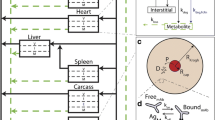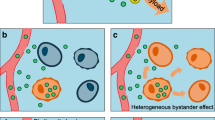Abstract
A mathematical model has been developed to optimize tumor targeting with labeled antibodies. The model is compartmental and nonlinear, incorporating saturable binding. Published parameter values have been used in the model, and the resulting stiff differential equations have been solved using FACSIMILE, a computer package that can simulate very stiff differential systems. Results show that successful tumor targeting depends on an optimal combination of antibody dose, affinity, and molecular size. The model has allowed an assessment to be made of the complicated and interrelated dynamic relationships that these factors have on tumor targeting. It has also offered an explanation for previously unsatisfactory results from tumor targeting with labeled antibodies. The structural identifiability of the model parameters is also analyzed and it is shown that, with the prior knowledge of some parameters which is likely in practice, the remaining model parameters are uniquely identifiable.
Similar content being viewed by others
References
P. W. Dykes, A. R. Bradwell, C. E. Chapman, and A. T. M. Vaughan. Radioimmunotherapy of cancer: Clinical studies and limiting factors.Cancer Treat. Rev. 14:87–106 (1987).
A. A. Epenetos, D. Snook, H. Durbin, P. M. Johnson, and J. J. Taylor-Papadimitriou. Limitations of radiolabelled monoclonal antibodies for localisation of human neoplasms.Cancer Res. 46:3183–3191 (1986).
C. H. J. Ford and A. G. Casson. Antibody-mediated targeting in the treatment and diagnosis of cancer: An overview.Cancer Chemother. Pharmacol. 17:197–208 (1986).
A. A. Epenetos, C. C. Nimmon, J. Arklie, A. T. Elliott, L. A. Hawkins, R. W. Knowles, K. E. Britton, and W. F. Bodmer. Detection of human cancer in an animal model using radiolabelled tumour-associated monoclonal antibodies.Br. J. Cancer 46:1–8 (1982).
A. M. Keenan, D. Colcher, S. M. Larson, and J. Scholm. Radioimmunoscintigraphy of human colon cancer xenografts in mice with radioiodonated monoclonal antibody B72.3.J. Nucl. Med. 25:1197–1203 (1984).
D. A. Scheinberg and M. Strand. Leukaemic cell targeting and therapy by monoclonal antibody in a mouse model system.Cancer Res. 42:44–49 (1982).
L. T. Baxter and R. K. Jain. Transport of fluid and macromolecules in tumours. 1-Role of interstitial pressure and convection.Microvas. Res. 37:77–104 (1989).
B. Ballou, J. Reiland, G. Levine, B. Knowles, and T. R. Hakala. Tumour localisation using F(ab′)2μ from a monoclonal IgM antibody: pharmacokinetics.J. Nucl. Med. 26:283–292 (1985).
J. A. Carrasquillo, P. G. Abrams, R. W. Schroff, J. C. Reynolds, C. S. Woodhouse, A. C. Morgan, A. M. Keenan, K. A. Foon, P. Perentis, S. Marshall, M. Horowitz, J. Szymendera, J. Englert, R. K. Oldham, and S. M. Larson. Effect of antibody dose on the imaging and biodistribution of Indium-111 9.2.27 anti-melanoma monoclonal antibody.J. Nucl. Med. 29:39–47 (1988).
R. M. Sharkey, F. J. Primus, and D. M. Goldenberg. Antibody protein dose and radio-immunodetection of GW-39 human colon tumour xenographs.Int. J. Cancer 39:611–617 (1987).
B. A. Brown, R. D. Comeau, P. L. Jones, F. A. Liberatore, W. P. Neacy, H. Sands, and B. H. Gallagher. Pharmacokinetics of the monoclonal antibody B72.3 and its fragments labeled with either125I or111In.Cancer Res. 47:1149–1154 (1987).
F. Searle, T. Adam, and J. A. Boden. Distribution of intact and Fab2 fragments of anti-human chorionic gonadotrophin antibodies in nude mice bearing human choriocarcinoma xenografts.Cancer Immunol. Immunother. 21:205–208 (1986).
R. M. Sharkey, F. J. Primus, D. Sochat, and D. M. Goldenberg. Comparison of tumour targeting of mouse monoclonal and goat polyclonal antibodies to carcinembryonic antigen in the GW-39 human tumour-hamster host model.Cancer Res. 48:1823–1828 (1988).
J. N. Weinstein, D. G. Covell, J. Barbet, R. R. Eger, O. D. Holton, M. J. Talley, R. P. Parker, and C. D. V. Black. Local and cellular factors in the pharmacology of monoclonal antibodies. In B. Bonavida and R. J. Collier (eds.),Membrane Mediated Cytotoxicity, Alan R. Liss, New York, 1987, pp. 279–289.
C. W. Gear.Numerical Initial Value Problems in Ordinary Differential Equations (Prentice-Hall Series in Automatic Computation), Prentice-Hall, Englewood Cliffs, NJ, 1971.
R. L. Dedrick, D. S. Zaharko, R. A. Bender, W. A. Bleyer, and R. J. Lutz. Pharmacokinetic considerations on resistance to anti-cancer drugs.Cancer Ther. Rep. (Part 1, No. 4) 59:795–804 (1975).
J. J. DiStefano III and R. F. Chang. Computer simulation of thyroid hormone binding, distribution and disposal dynamics in man.Am. J. Physiol 221:1529–1544 (1971).
K. R. Godfrey and J. J. DiStefano III. Identifiability of model parameters. In E. Walter (ed.),Identifiability of Parametric Models, Pergamon, Oxford, 1987, pp. 1–20.
H. Ishikawa, T. Maeda, H. Hikita, and K. Miyatake. The computerised derivation of rate equations for enzyme reactions on the basis of the pseudo-steady-state assumption and the rapid equilibrium assumption.Biochem. J. 251:175–181 (1988).
K. Koizumi, G. L. DeNardo, S. J. DeNardo, M. T. Hays, H. H. Hines, P. O. Scheibe, J-S. Peng, D-J. Macey, N. Tonami, and K. Hisada. Mutticompartmental analysis of the kinetics of radioiodinated monoclonal antibody in patients with cancer.J. Nucl. Med. 27:1243–1254 (1986).
D. G. Covell, J. Barbet, O. D. Holton, C. D. V. Black, R. J. Parker, and J. N. Weinstein. Pharmacokinetics of monoclonal immunoglobin G1, F(ab′)2 and Fab′ in mice.Cancer Res. 46:3969–3978 (1986).
R. R. Eger, D. G. Covell, J. A. Carrasquillo, P. G. Abrams, K. A. Foon, J. C. Reynolds, R. W. Schroff, A. C. Morgan, S. M. Larson, and J. N. Weinstein. Kinetic model for the biodistribution of an111In-labeled monoclonal antibody in humans.Cancer Res. 47:3328–3336 (1987).
B. R. Zeeburg and H. N. Wagner, Jr.. Analysis of 3- and 4-compartment models for in vivo radioligand-neuroreceptor interaction.Bull. Math. Biol. 49:469–486 (1987).
A. R. Curtis and W. P. Sweetenham.FACSIMILE/CHEKMAT Users' Manual, Harwell Laboratory Report (AERE 12805), 1987.
K. R. Godfrey.Compartimental Models and Their Application, Academic Press, New York, 1983.
S. W. Benson.The Foundations of Chemical Kinetics (McGraw-Hill Series in Advanced Chemistry), McGraw-Hill, New York, 1960.
J. A. Jacquez.Compartmental Analysis in Biology and Medicine, University of Michigan Press, Ann Arbor, 1985.
S. I. Rubinow. Mathematical problems in the biological sciences.Regional Conference Series in Applied Mathematics, Vol. 10, Society for Industrial and Applied Mathematics, Philadelphia, 1973.
G. D. Thomas, M. J. Chappell, P. W. Dykes, D. B. Ramsden, K. R. Godfrey, J. R. M. Ellis, and A. R. Bradwell. Effect of dose, molecular size, affinity and protein binding on tumor uptake of antibody or ligand: a biomathematical model.Cancer Res. 49:3290–3296 (1989).
A. E. Taylor and D. N. Granger. Exchange of macromolecules across the microcirculation. InHandbook of Physiology, 4th ed., Section 2, Vol. 4, Part 1, pp. 467–520, Waverley Press, Baltimore, MD, 1984.
S. O. Fatunla.Numerical Methods for Initial Value Problems in Ordinary Differential Equations, Academic Press, New York, 1988.
L. F. Shampine and C. W. Gear. A user's view of solving stiff differential equationsSIAM Rev. 21:1–17 (1979).
Advanced Continuous Simulation Language (ACSL) Reference Manual, Mitchell and Gauthier Associates, Concord, MA, 1986.
SAS/GRAPH Version 5 Users' Manual, SAS Institute, Cary, NC, 1985.
K. R. Godfrey and W. R. Fitch. The deterministic identifiability of nonlinear pharmacokinetic models.J. Pharmacokin. Biopharm. 12:177–191 (1984).
S. M. Larson, J. A. Carrasquillo, K. A. Krohn, J. Brown, R. W. McGuffin, J. M. Ferens, M. M. Graham, L. D. Hill, P. L. Beaumier, and I. Hellstrom. Localisation of131I-Labeled p97-specific Fab fragments in human melanoma as a basis for radiotherapy.J. Clin. Invest. 72:2101–2114 (1983).
A. J. McEwan, B. Shapiro, J. C. Sissou, W. H. Birwaltes, and D. M. Ackery. Radioiodobenzylguanidine for the scintigraphic location and therapy of adrenergic tumours.Semin. Nucl. Med. 15:132–153 (1985).
H. Pohjanpalo. System identifiability based on the power series expansion of the solution.Math. Biosci. 41:21–33 (1978).
S. Wolfram.SMP: User's Manual Version 1.5.0., Inference Corp., 53000 West Century Building, Los Angeles, 1983.
M. J. Chappell, K. R. Godfrey, and S. Vajda. Global identifiability of the parameters of nonlinear models with specified inputs: a comparison of methods.Math. Biosci. 102:41–73 (1990).
M. J. Chappell and K. R. Godfrey. Identifiability of a model developed for optimal tumour targeting by antibodies: the application of a symbolic manipulation package.University of Warwick, Control and Instrument Systems Centre, Report No. 5 (1989).
D. G. Garlick and E. M. Renkin. Transport of large molecules from plasma to interstitial fluid and lymph in dogs.Am. J. Physiol. 219:1595–1605 (1970).
R. M. Watt, J. M. Herron, and E. W. Voss. First order dissociation rates between a subpopulation of high-affinity rabbit anti-fluorescyl IgG antibody and homologous ligand.Mol. Immunol. 17:1237–1243 (1988).
E. P. Krenning, W. A. P. Breeman, P. P. M. Kooij, J. S. Lameris, W. H. Bakker, J. W. Koper, L. Ausema, J. C. Reubi, and S. W. J. Lamberts. Localisation of endocrine-related tumours with radioiodinated analogue of somatostatin: Preliminary Communication.Lancet No. 8632:242–244 (1989).
Author information
Authors and Affiliations
Rights and permissions
About this article
Cite this article
Chappell, M.J., Thomas, G.D., Godfrey, K.R. et al. Optimal tumor targeting by antibodies: Development of a mathematical model. Journal of Pharmacokinetics and Biopharmaceutics 19, 227–260 (1991). https://doi.org/10.1007/BF01073870
Received:
Revised:
Published:
Issue Date:
DOI: https://doi.org/10.1007/BF01073870




